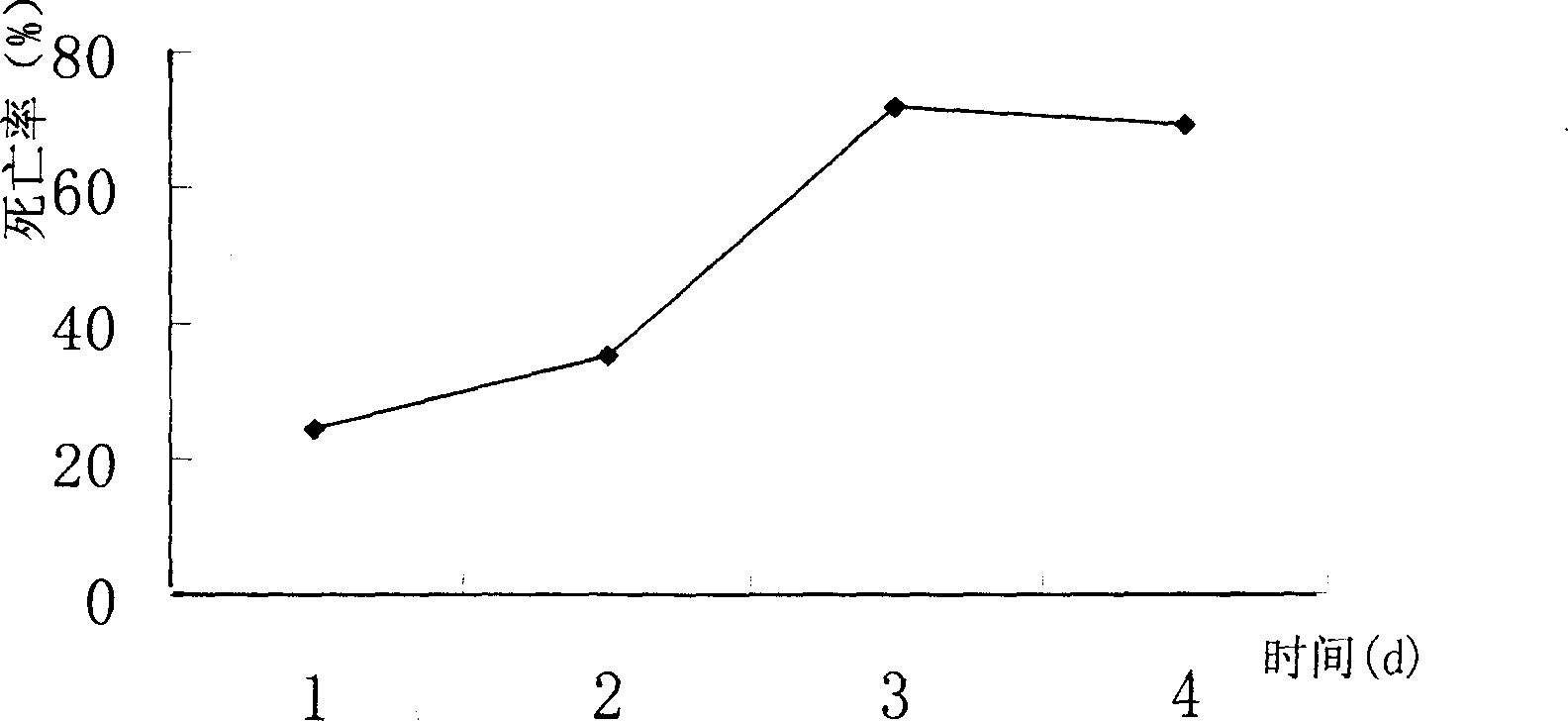Culturing method of sea source bacillus subtilis insect killing activity product and its application
A technology of Bacillus subtilis and insecticidal activity, which is applied in the field of cultivation of marine source Bacillus subtilis insecticidal activity products, can solve problems such as no reports, achieve good control effect, simple fermentation conditions, environmental and non-target biological safety Effect
- Summary
- Abstract
- Description
- Claims
- Application Information
AI Technical Summary
Problems solved by technology
Method used
Image
Examples
Embodiment 1
[0014] Example 1: Screening method for a marine source insecticidal microorganism
[0015] 1. The culture conditions of marine microorganisms to be tested: medium composition: add 2.0% soluble starch, 1.5% soybean powder, 0.5% yeast extract, 0.2% peptone, carbonic acid Calcium 0.2%, glucose 0.5%, and adjusted to pH 7.5-8.0; inoculum size: 1% seed solution equivalent to the total amount of the medium, cultured at 28°C, 200r / min shaker for 120h. The fermentation broth was centrifuged, and the supernatant was taken for testing the insecticidal activity.
[0016] 2. Conventional insect soaking screening method: take the 3rd instar cotton bollworm larvae that have been continuously raised indoors for multiple generations, soak them in the fermentation liquid stock solution for 30s, place them in finger tubes (one head per tube) with feed, and soak the blank controls separately. Clean water, soaked in fermentation medium, 20 3rd instar larvae per treatment. After treatment, place ...
Embodiment 2
[0021] Example 2: Fermentation and cultivation method of a marine source insecticidal microorganism
[0022] 1. Determination of fermentation time: Inoculate 1% seed liquid in the culture medium, ferment for 1d, 2d, 3d, 4d respectively, measure the activity of the fermentation broth, and determine the relationship between fermentation time and activity (see figure 1 ).
[0023] 2. Carbon source experiment: use 3.5% corn flour, 3.5% soluble starch, 3.5% maltose, 3.5% sucrose, 3.5% glucose, and 3.5% lactose to replace soluble starch and glucose in the medium, ferment for 3 days, and test the activity of cotton bollworm (See figure 2 ).
[0024] 3. Nitrogen source experiment: 1.7% soybean powder, 1.7% peptone, 1.7% beef extract, 1.7% yeast extract (imported), and 1.7% concentrated yeast powder (domestic) were used as nitrogen sources to replace soybean powder in the medium respectively Yeast extract, fermented for 3 days, assayed by cotton bollworm (see image 3 ).
[0025]...
Embodiment 3
[0049] Example 3: Determination of insecticidal spectrum of a marine source insecticidal microbial fermentation product (see Table 3 for specific results)
[0050] 1. Insect soaking method Put the 3rd instar larvae of cotton bollworm, cabbage worm, cabbage worm and armyworm continuously raised in the room into the concentrated solution of JAAS01 fermentation broth for 30s, and then insert them into fresh cotton, cabbage, small green vegetables, In the petri dishes of cabbage and corn leaves (petioles containing 0.2% NaNO 3 , 0.1%K 2 HPO 4 20 third-instar larvae per dish, each treatment was repeated 3 times, and after treatment, the temperature was 25±0.5°C, the photoperiod L:D=14:10, and the relative humidity was 75%-85°C. % raised in the incubator. 48h to check the larval mortality.
[0051] 2. Leaf soaking method: Cut the leaves of cabbage with aphids aphids into small pieces, put them into the JAAS01 fermented broth concentrate and soak them for 10 seconds, absorb exces...
PUM
 Login to View More
Login to View More Abstract
Description
Claims
Application Information
 Login to View More
Login to View More - R&D
- Intellectual Property
- Life Sciences
- Materials
- Tech Scout
- Unparalleled Data Quality
- Higher Quality Content
- 60% Fewer Hallucinations
Browse by: Latest US Patents, China's latest patents, Technical Efficacy Thesaurus, Application Domain, Technology Topic, Popular Technical Reports.
© 2025 PatSnap. All rights reserved.Legal|Privacy policy|Modern Slavery Act Transparency Statement|Sitemap|About US| Contact US: help@patsnap.com



